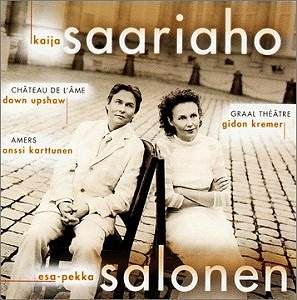So far Kaija Saariaho has been known for a number of
chamber works for ensemble, small and large, characterised by a sharp
ear for arresting sonorities, and her deft use of electronics in one
form or another. These skills she uses with much subtlety, refinement
and great poetical insight. Her works are recognised above all for her
convincing way of combining her techniques to reveal her highly personal
vision, often influenced by nature. This is certainly the case in Lichtbogen
(1985/6) – one of her most successful pieces so far – and also in Nymphea
(1987) for string quartet and electronics.
In its own way, Saariaho’s music, for all its uncompromising
ruggedness, is impressionistic. The most remarkable characteristic of
her music is that all the techniques on which she relies, including
electronics and "spectral" harmonies, are exclusively used
for expression’s sake. Her first large-scale orchestral piece Verblendungen
(1982/4), a rather abstract piece as a whole, also impresses by the
sheer weight of the massive magma waves she generates. This powerful
piece led to the masterly diptych Du cristal... (1989/90)
and ...à la fumée (1990), the latter featuring
amplified cello and alto flute. By that time Saariaho had become master
of her trade and fully equipped to undertake highly varied enterprises
of which the high water mark so far is her opera L’Amour de Loin
completed in 1997.
This generous release usefully couples a comparatively
early piece with two recent ones written in the wake of the opera. Amers
(1992) for cello and ensemble still clearly belongs to Saariaho’s earlier
years in its uncompromising single-mindedness. The composer tells Martin
Anderson that the piece focuses heavily on colour rather than line.
Some "spectral" techniques enhance the timbral aspect of the
music, particularly in the taxing cello part. She imagined a boat trip
through often agitated waters ("amers" is the French for "sea-marks").
So the music moves on restlessly, almost recklessly, with unflagging
energy. A tough nut to crack but one well worth cracking.
Graal Théâtre for violin
and orchestra is a quite different proposition. The title comes from
a book by Jacques Roubaud; Graal implying some sort of quest
reflected in the music of the first part whereas théâtre
rather refers to conflict, opposition and clash between antagonistic
forces. The dual title is reflected in the bipartite structure of the
piece. The opening movement Delicato opens mysteriously, with
delicate textures sustaining the violin’s incantations. The second movement
Impetuoso is more nervous, brimming with energy and full of conflicting
ideas. A beautiful work superbly played by Gidon Kremer for whom it
was written.
Château de l’Ame, completed in
1996, clearly belongs to the same world as the opera and it is a wonderful
example of Saariaho’s lyricism. This beautiful piece, one of Saariaho’s
finest works so far, is her most poetical and subtle work. Scored for
soprano, small chorus and orchestra, it sets several ancient texts (in
French translation) about different aspects of Love (unfortunately the
texts are not printed in the insert notes) and brims with delicate orchestral
textures far removed from those of Saariaho’s earlier, harsher works.
A wonderful, lyrical piece of great beauty and refinement.
All the performers here have a long association with
Saariaho’s music and it receives superb, warmly recorded performances.
This release is a wonderful tribute to this most distinguished composer
whose superbly crafted music, even at its most demanding, is capable
of deeply-felt emotions. Unreservedly recommended.
Hubert Culot

![]() Gidon Kremer (violin);
Dawn Upshaw (soprano)²; Anssi Karttunen (cello)³; BBC Symphony Orchestra;
members of the Finnish Radio Chamber Choir and Finnish Radio Symphony
Orchestra²; Avanti! Chamber Orchestra³; Esa-Pekka Salonen
Gidon Kremer (violin);
Dawn Upshaw (soprano)²; Anssi Karttunen (cello)³; BBC Symphony Orchestra;
members of the Finnish Radio Chamber Choir and Finnish Radio Symphony
Orchestra²; Avanti! Chamber Orchestra³; Esa-Pekka Salonen ![]() SONY SK 60817 [71:31]
SONY SK 60817 [71:31]